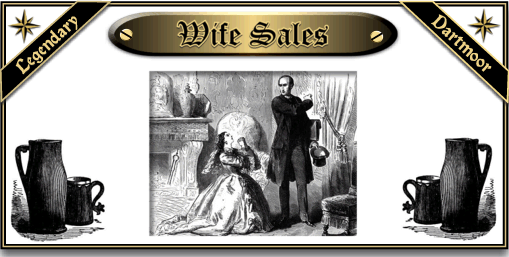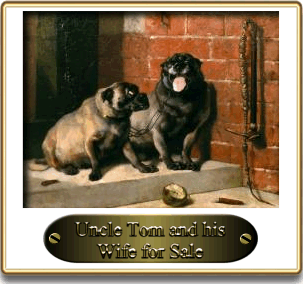
Before proceeding I would like to point out that what follows is not sexist, male chauvinism or misogynistic, it’s simply historical fact. Now as a rule a moorman has an eye for a good beast and an even better one for a profit, it’s an ability that comes with living on the moor. Occasionally things go wrong and they may be stuck with a, “bad doer”, which resulted from a temporary lapse in concentration – ’tis easy done. What at first glance appears to be a fine specimen with plenty of potential ends up like a chapel hat rack and simply has to go. It is probably this ethos that lead to the practice of wife sales. Yes, back as recently as the eighteenth century it was not unheard of to either buy or sell a wife at market. The usual reason for the sale was exactly as described above – she was a bad doer and had to go. Similarly, the reason for the purchase was that in the buyer’s eye she had plenty of potential to do well and make a good wife.
Baring Gould (1908, pp. 58 – 69, 1890, p.267) tells of a village poet/minstrel who went to Okehampton Giglet Fair where he spotted a man who had a wife for sale. Apparently the reason for the sale was that the husband had grown weary of, “her temper and tongue”, and so she had to go. After much haggling he managed to do a deal and bought the woman for half a crown, the money came from the sale of one of his poems. Now tradition of the time had it that to make the transaction legal the woman had to be led home with a halter around her neck and until they crossed the threshold she wasn’t allowed to take it off. In this case it meant a journey of 12 miles during which the poet solemnly led the woman along the road with a noose around her neck. It seems that someone at the market managed to get back to his home village before the poet and spread the news that Henry Frise, for that was the poets name, was bringing home a brand new half a crown wife. By the time the ‘happy’ couple reached the village the main street was lined with curious spectators.
Both the local squire and the vicar tried to convince the poet that was not legally married to Anne, for that was his new wife’s name. But Henry was having none of it and insisted that because he had paid his half a crown and led her the 12 miles home by a halter, in his eyes, they were legally wed. But what of the marriage? Baring Gould tells us (1890, p.267):
“She lived with the purchaser till her death, and a very clean, decent, hard-working woman she was. She had indeed a tongue; but when she began to let it wag, then the minstrel clapped his hands to his eras, ran out of the house, and betook himself to the ale-house, where he was always welcome, and from which he did not himself return, but was conveyed home – in a wheel barrow“.
Anne Frise died before Henry and then the whole business of a legal wedding reared its ugly head again. The parson refused to enter Anne Frise on the register of deaths because she had not been properly married and was not entitled to be called Frise. Henry, quite understandably, got a bit peeved and ended up taking Anne’s corpse to another parish for burial. Here the local parson knew naught of the events and entered Anne Frise in the register, all this happened sometime around the early 1800’s.
He relates another story from the other aspect and that of the seller. There was a local stone-cutter who for one reason or another had become to the conclusion that his wife was a bad doer. Therefore he draughted the following notice which was displayed in several public places in his locality:
“This here be to hinform the publick as how James Cole be disposed to sell his wife by auction. Her be a dacent, clanely woman, and be age twenty five ears. The sale be to take place in the New Inn, Thursday next at seven o’clock“.
The day of the sale arrived and so at the New Inn did James Cole with lot number one, his wife, who was made to stand on a table for all the bidders to see. Now somebody had told Cole that for the sale to be legal it must be conducted by a licensed auctioneer and no money should change hands. Accordingly, the stone-cutter had equipped himself with a lump hammer which in his eyes was a gavel and that made him an official auctioneer. Having explained that the bids were to be in kind the auction was opened. Bidding began by a small man offering his coat but as Cole was a large man this tender was refused. Things moved on a pace and another man offered his new pick axe but again Cole already had one and that bid was refused. Finally the landlord of the New Inn bid a two gallon jar of gin, the hammer went down with such speed that nobody had a chance to improve on the offer.
In the 1860’s a man from North Bovey walked into Chagford and in one of the inns sold his wife by private agreement for a quart of beer. Having struck a deal he took the purchaser back to his house to collect the wife. She was having nothing to do with the arrangement and so took her children and moved to Exeter to live.
The vicar of North Bovey had a theory on the matter of wife sales, he considered that whether by private arrangement or public auction the sale of a wife never realised a large sum. He also noted that when a marriage was on the rocks the husband usually thought it best to take whatever he could than to have to take his wife home again.
Baring Gould suggested that the origins of wife sales stemmed back to when it was tradition for a prospective husband to pay the father for his daughter. Having actually paid for a wife the husband, should he ever wish to be separated, would negotiate a market price or going rate with any interested buyer as he would any sheep, cow or pig. In other words everything had a value and in pastoral areas where a man’s wealth was calculated by his stock numbers and chattels the wife was, having paid for her, included. In the 1800s Sir Edwin Landseer painted a picture of two dogs, a happy looking male and a forlorn female with a halter/chain around her neck which he called – ‘Uncle Tom and his Wife for Sale’.

Today, it is estimated that between 1780 and 1850 about 300 wife sales took place in England. One reason for this popularity was the fact that obtaining an official divorce was virtually impossible for the lower classes. Therefore when a couple mutually agreed that they wanted to separate the idea of an auction served as a way of getting some kind of public recognition for the dissolution of their marriage. Hence the reason for them taking place at markets or inns, these were about the most public of secular buildings. It is a well known fact that the upper classes deplored this tradition, whether out of the fact that their status meant they couldn’t do the same nobody knows. On the 18th of July 1797 The Times newspaper reported the following:
“On Friday a butcher exposed his wife to sale in Smithfield Market, near the Ram Inn, with a halter about her neck, and one about her waist, which tied her to a railing; when a hog driver was the happy purchaser, who gave the husband three guineas and a crown for his departed rib. Pity it is there is no stop put to such depraved conduct in the lower order of people.”
Once having been sold, in what regard was the wife held amongst the local people who clearly knew of the transaction? In the 1840s one early commentator noted that whilst riding down a lane one day he came across a farmer stood beside the road. With him, wearing only her shift and a rope around her neck was a woman who it transpired was his wife. The farmer was offering her for sale at the princely price of ten shillings to all the travellers who passed. Eventually the woman was purchased and it seems was always held in the same regard by the locals as if her and her new husband had been legally married.
Many people found/find this tradition totally unacceptable which initially it was but when the true reason for it is considered it was a way around the divorce laws for poor couples who wanted to separate with some kind of formality. But, has it truly ended? In 2005 a man attempted to sell his wife on eBay who removed his listing. Not to be deterred he posted his own website called ‘Wife for Sale’ on which the following appeared:
“Well I think much people are wondering what this site is all about. I’ve got a very interesting offer for you all. I’ve been married 23 years with my wife Petra. Our relationship isn’t anymore what it’s used to be. She starts complaining when I look at younger girls or if I come home drunk. I’ve been using the internet since a few weeks ago now. I’ve seen much interesting things on the internet, especially the sites like E-bay. Selling and buying while staying home is one of the most interested things I’ve seen in a long time. After a short time I got a great idea. The idea to sell my wife, but E-bay banned me from using their site for some reason. That’s why I’ve made this site, to sell my wife”.
Bibliography.
Baring Gould, S. 1908 Devonshire Characters and Strange Events – 1st Series, John Lane, London.
Baring Gould, S. 1890 Old Country Life, Methuen & Co., London
 Legendary Dartmoor The many aspects past and present of Dartmoor
Legendary Dartmoor The many aspects past and present of Dartmoor

simply Stunning perspective Tim! Thank You for enlightening Landseer’s ‘Uncle Tom & wife for sale’. it epitomises the exceptional artist’s social empathy- concerned not just with the ‘rights’ of dogs and horses, but for the liberty of man’s favourite possession- women. You may know, the Queen’s favourite person/painter supported many pioneering women emotionally and financially, before they achieved success or fame, from Caroline Norton (1st Family Act 1838) to Flo Nightingale, and many, and much of our cultural heritage in between.
Very interesting article. I am glad I found this website